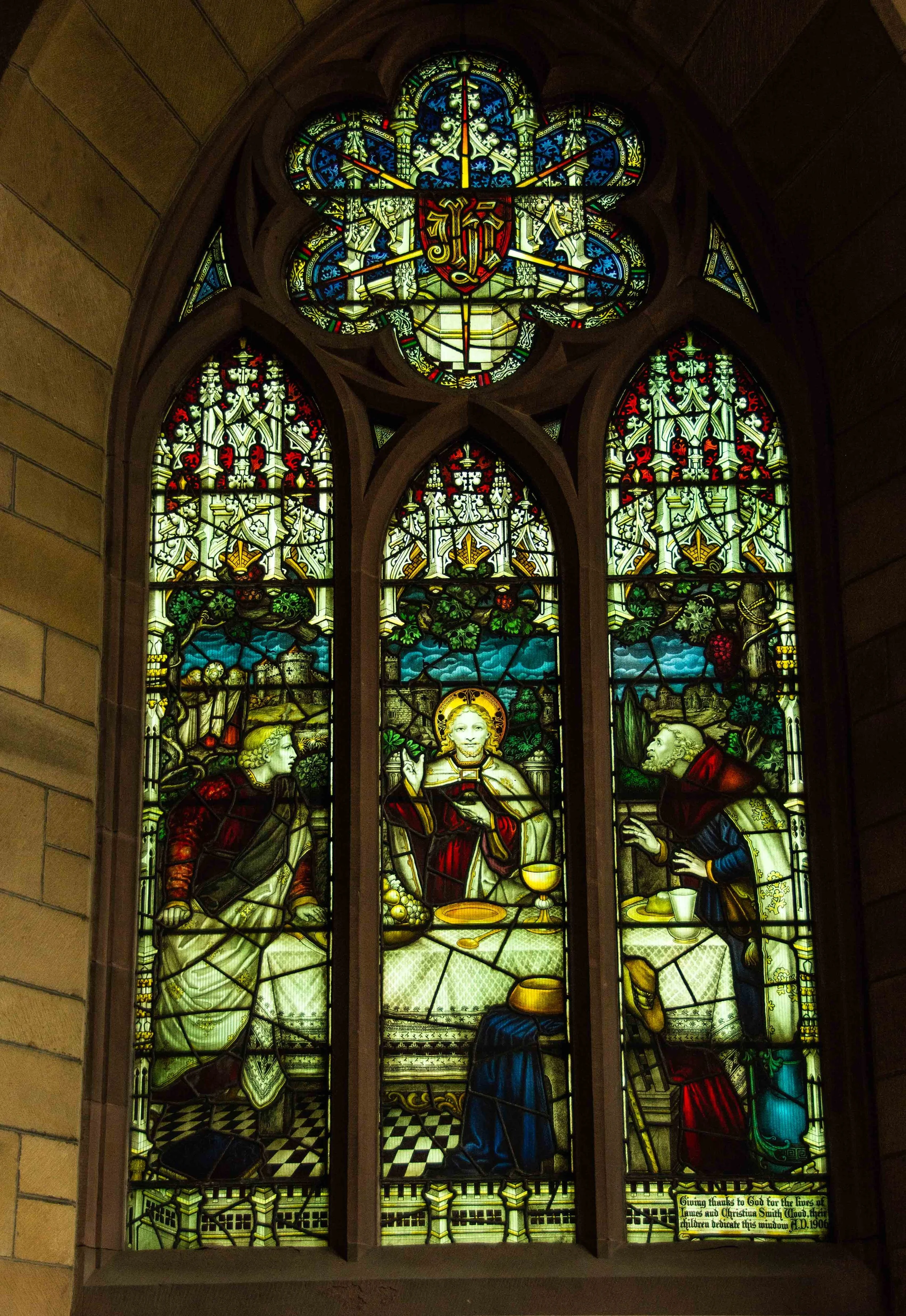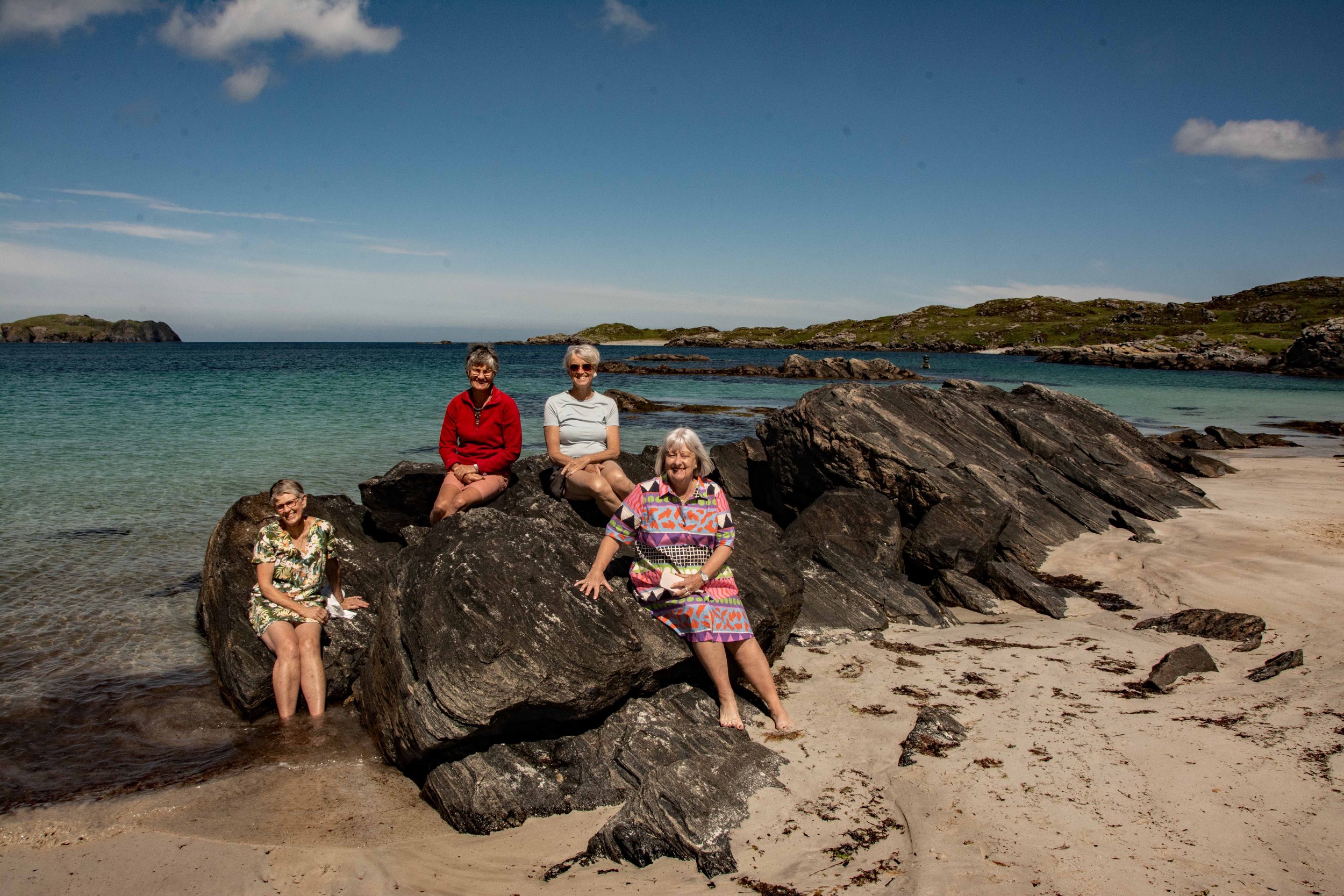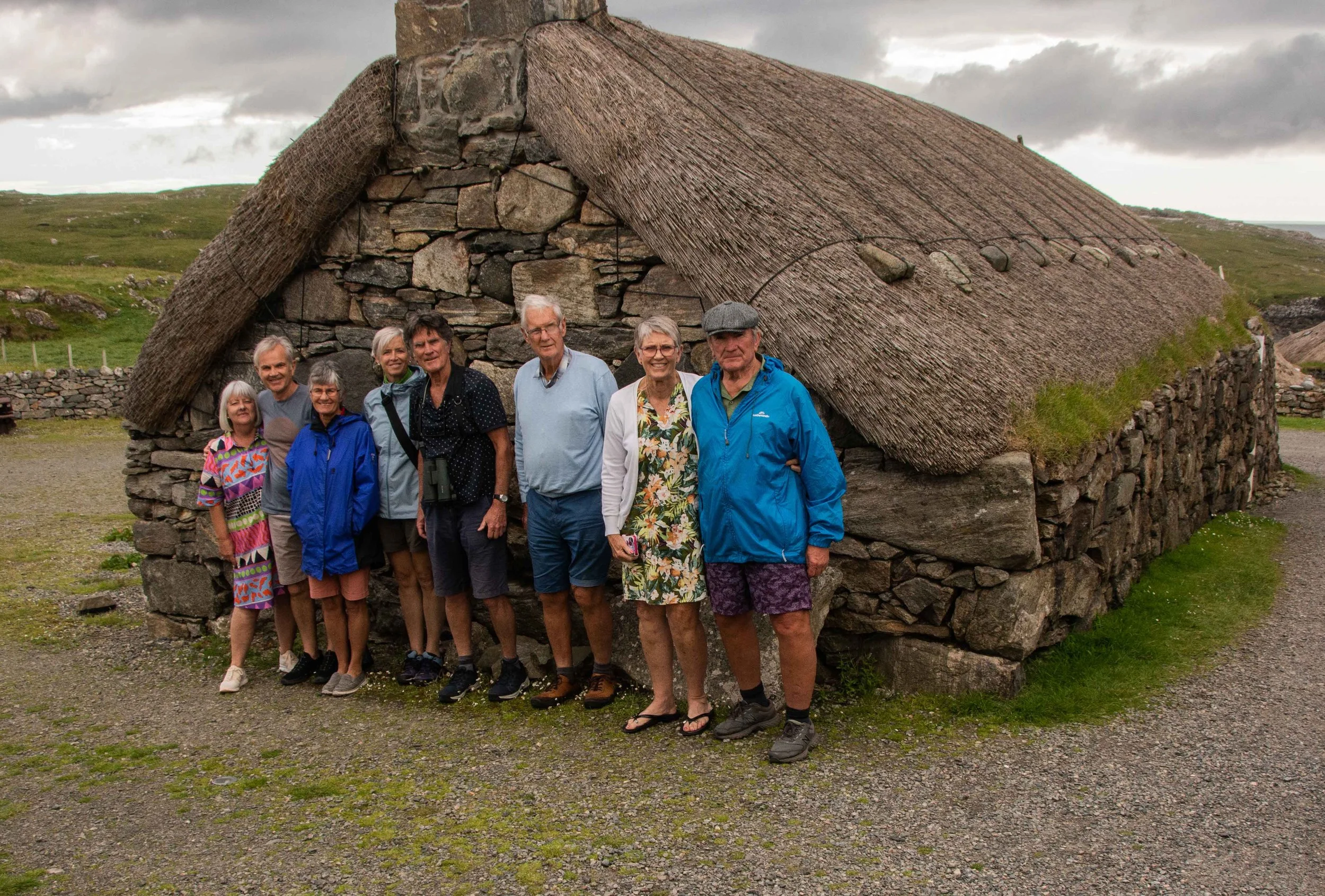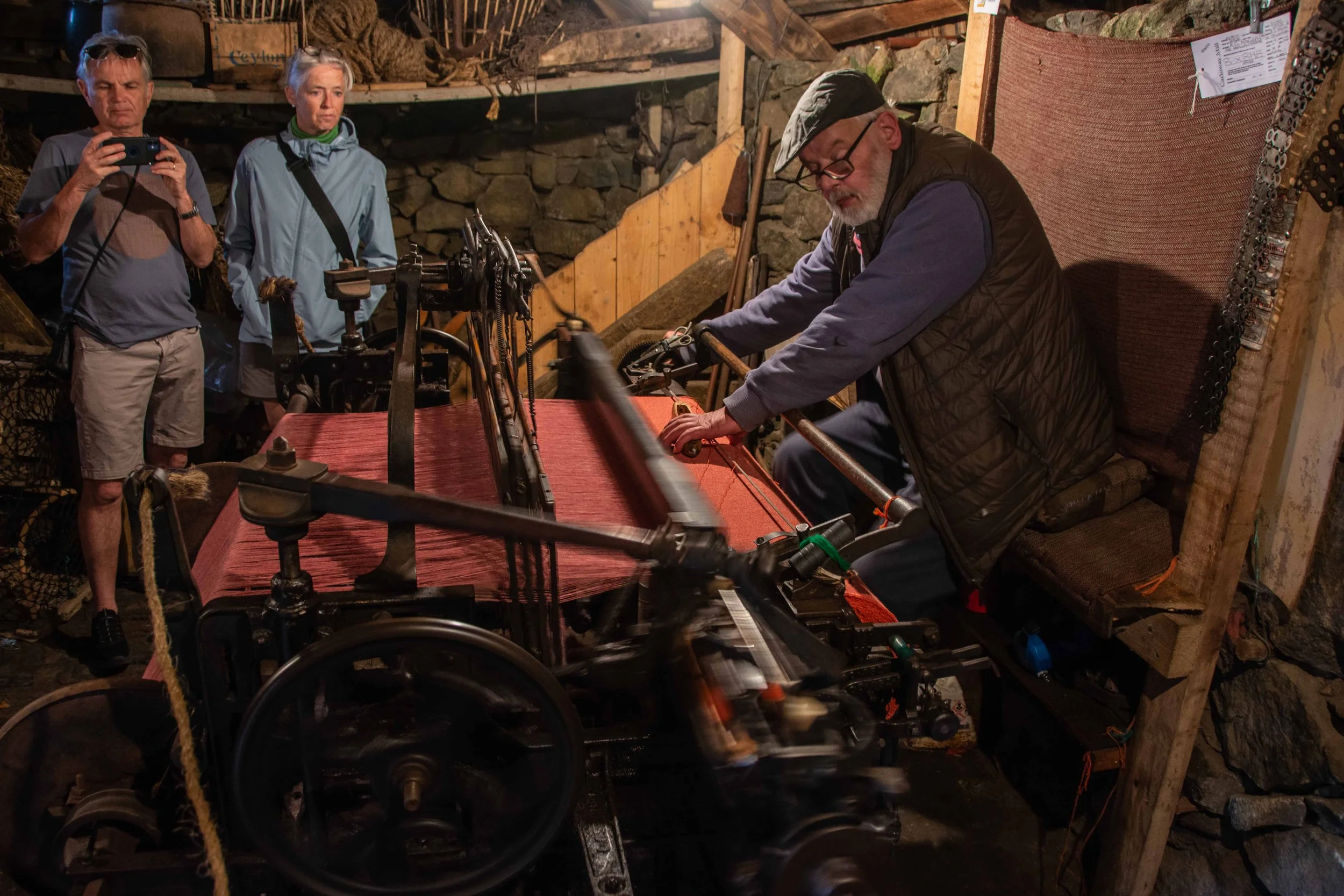In July the Wood family united in the town of Melrose in the Scottish borders. The reason for this trip was to lay the ashes of our parents to rest in the graveyard of Earlston Parish Church where many generations of our ancestors are buried. Our father died in 2006 at the age of 94 and our mother in 2020, a few months short of her 100th birthday. Since their deaths their ashes have been in the care of Heather in New Zealand
Our grandfather, David Wood was born in Earlston in 1865 and emigrated to South Africa in 1893. Dad was very proud of his Scottish roots, although mother teased him by suggesting that he came from a line of border cattle thieves, known as reivers. (There is no evidence for this). Through much detective work by Heather on ancestry websites, she discovered the extensive family roots in Earlston and surrounding towns.
Photo 1. The Wood family sometime in the 1870s. L-R. Our grandfather David, our great grandfather James, sister Harriet and great grandmother Margaret.
It took quite a degree of planning and coordination to get the four siblings and their spouses together in one place at the same time. Unfortunately, Ursula was only able to arrive a week later due to pressure of work. However, Mike and Marg, and Heather and Brian from New Zealand, and Barbara and Martin from South Africa, and myself, Chris, from Switzerland, eventually assembled in Melrose where we spent several days exploring the family roots in the area.
Photo 2. The Earlston Parish Church and cemetery
In the cemetery we found many gravestones of the various relatives and relatives by marriage of our family. The Woods, Walkers, Shillinglaws and Landells are all buried in the cemetery. Before the twentieth century people usually did not move far from their place of birth, and in time, in a small community like Earlston, most families would be related to each other by marriage.
One thing I had not expected was the beautiful stained-glass window dedicated to our great-grandparents by their children. I particularly liked the faces in the window.
Photo 3. In the bottom right hand corner the inscription reads: “Giving thanks to God for the lives of James and Christina Smith Wood their children dedicate this window AD1906.”
We met with the undertaker who had made the necessary arrangements and we went on to meet with the minister, Marion Dodd, who would conduct the service, at her house. With her we discussed the history of the family and related anecdotes we remembered and it was agreed that Michael and I would each give a short speech, Mike on his recollections of our father, and me of our mother.
On the day, we held a short service in the church and then trooped outside and laid the ashes of our parents in the grave of our great-grandparents.
Photo 4. The gravestone of our Great-grandfather and his family
The names recorded on the stone read
James Wood, died 1896 aged 65
His wife Christina Smith Wood, died 1905 aged 79
Their daughter Eleanor Catherine died 1871 in her 4th year
Daughter Harriet Margaret Wood died 1912 aged 49.
Photo 5. Barbara laying one of the caskets into the grave, watched by Marion Dodd and the undertaker.
Photo 6. Marg laying a rose on the caskets.
After the service we retired to a local pub and had a whisky in commemoration of our parents. I am not sure that Mom would have approved, “we might become alcoholics.”
Our mission accomplished, we embarked on an exploration of the district guided by Heather’s detailed research. Everyone we met was most helpful; I am not sure whether it has anything to do with Scotland’s desire for independence from England, but we found a great interest in local history wherever we went. We were shown a painting of the school house where our great-great- grandfather, a school master, and family, had lived and where our great-grand father had spent his early years. The family lived downstairs, below the Court House upstairs.
Photo 7. A painting of the school house. The family lived downstairs on the right and the school was downstairs on the left. The entrance to the school is hidden by the angled staircase leading to the Court House.
Also, we were shown a photograph of the school house taken in the 1890s, after the family had moved. The school house still stands to this day, but is now a private residence, the school having moved to more modern premises some decades ago. We were, unfortunately, unable to go inside as the present owner was away on holiday in France.
Photo 8. The school house in the 1890s, second building on the right; by now the outside steps had been removed. The staggered windows are still there today.
Our great-grandfather James became a draper and then wool buyer in Galashiels where he had a house “Woodburn” built. The house still stands and the present owner invited us into the house and took us on a tour of her garden and pointed out the stream or burn at the bottom of a slope down from the garden.
Photo 9. The house Woodburn built by great- grand father James.
He also invested in property and built a short row of houses, named Woodsidehouse, in Earlston. Obviously proud of the family name.
Photo 10. Most of the family gathered outside Woodside House
We explored the countryside and following signs promising Roman ruins and an amphitheatre, and we strode along country lanes searching for the promised site. All we found were barley fields. Finally, we came upon this informative pillar.
Photo 11. The pillar.
It was apparent that the ruins were buried under the fields, so nothing to see, but I am sure, archeologically speaking, very interesting nonetheless. The site is just south of Hadrian’s wall, built to keep the feared Scots in Scotland. It is obvious that the Scots were a force to be reckoned with 2000 years ago.
To make up for the lack of observable Roman ruins, there is a beautiful arched brick bridge, the Leaderfoot viaduct, over the River Tweed at the foot of the hill. I hoped to be able to walk across it, but, unfortunately, it has been, closed for safety reasons. Foiled again!
Photo 12. The. Leaderfoot railway viaduct, opened in 1863
We made a short foray to Edinburgh to attend a concert by Rod Stewart. I must admit that I was not expecting too much; of course, we all knew his old hits, but he is getting on, as are we all. In fact, he gave a tremendous concert. A real professional in the best sense. We were all blown away by the performance. Everyone in the audience knew all the words to all his songs and sang along with gusto. He is Scottish and the Scots obviously love him, at least those in the audience, who ranged from young teenagers to people older than us!
Ursula arrived from Switzerland, and the pretext for the trip accomplished, we set off on our holiday. First stop, the island of Lewis, where we hoped to find the house where Marg was born and spent the first years of her life before her parents emigrated to New Zealand.
We passed through Glasgow, all too short a time there, the city really deserves to have time spent there exploring the many museums, galleries and other cultural highlights for which Glasgow in famous.
Photo 13. Geoge Square, the central square, in Glasgow
The ferry to Stornaway, the port on Lewis, leaves from Ullapool and the drive across Scotland to get there was lovely. The Highlands more than equalled our preconceived ideas; the spectacular views and rolling hills, and more lochs than we had expected; at the foot of almost every hill there seemed to be a loch.
Photo 14. A break for the family at a loch on the way to Ullapool
Loch Broom is about 10 miles long, opening to the sea at the western end. The port of Ullapool lies about halfway along it. The road follows southern shore of the loch and the views it gave were simply stunning. Incidentally, the name “Loch Broom” means, according to Wikipedia, “Loch of Rain Showers.”
Photo 15. Looking down Loch Broom towards Ullapool.
Ullapool is a lovely, small, port town catering largely to the tourists arriving from or leaving for Stornaway, but it is also a working fishing port. Tourism is limited to spring and summer along the west coast as few if any tourists are ready to brave the winters here, when the showers sweep in from the sea and the loch lives up to its name.
Photo 16. Ullapool is a fishing harbour, with langoustine, the principle catch, exported to Europe.
The ferry was larger than I had anticipated with decks on two levels for cars, and with two large passenger decks.
Photo 17. Everybody catered for, even horses.
All aboard and off we went. Almost immediately the vibration from the engines set off the first car alarm, and that seemed to set off the second until there was an almost continuous chorus of car alarms. What the horse made of it I can’t imagine. The loch soon lived up to its name, with showers following the ferry until we reached to open sea.
Photo 18. Leaving Ullapool behind.
From the decks we had good views of the marine bird life, mainly puffins and guillemots. We were advised to watch out for whales which are occasionally seen during the crossing, but no luck this time, although we did catch glimpses of porpoises, or were they dolphins? We landed in Stornaway, the port for Lewis, and drove south to where we had booked a B&B
Photo 19. The view from the B&B
The house where we stayed on Lewis was on the East coast and had the most glorious view across the sea. Another tiny fishing harbour, langoustine again. Unfortunately, the house only took six people and our party was eight, so Mike and Marg put up at an hotel in Stornoway, but stayed to eat with us each evening.
Photo 20. Evening drinks in the garden
On a glorious sunny day we headed for the beach, Bosta beach, on the west coast. According to the guidebooks, it is reputed to be on of the most beautiful of beaches in the world. I wouldn’t go quite that far, but it is certainly beautiful
Photo 21. Enjoying the sun at Bosta beach. Marg and Ursula took a swim, but the Atlantic was a bit too cold for the rest of us.
Marg’s mother was brought up on one of the small islands off shore here, but we were not able to decide which, although the island in the background on the left seemed a serious possibility. Nowadays they are all uninhabited, not surprising given that the only access to the Lewis would have been by rowboat.
Photo 22. A view from the top
Some of us scrambled to the top of the headland to get a perspective over the bay and a better view of the islands. The vegetation here hugs the ground, seeking shelter from the wind.
Leaving Bosta Bay we visited a Henge, the Calanais Standing Stones, not quite on the scale of Stonehenge in England, but impressive nonetheless, and built about 2500 BC, ie over 4000 years ago, and before Stonehenge itself.
Photo 23. The Calanais standing stones. The largest of several to be found in the area
One thing about Lewis, the Hebrides in general probably, is that whatever the weather is it doesn’t last for long. It is quite often possible to experience several seasons in an afternoon. By the time we made our next stop, at the Gearrannan Black Cottages, it was overcast and becoming chilly.
Gearrannan village was inhabitet until about 50 years ago, and was a traditional crofting village. It has been restored and now provides accommodation hikers and holiday makers as well as an insight into the living conditions of the inhabitants.
Photo 24. The whole family gathered at a stone built cottage at the Black Village. The cottages are small, quite low, and thatched.
The cottages have been restored inside to give a tableau of what they looked like when inhabited.
Photo 25: The interior of one of the cottages as it looked when inhabited as late as the 1950s
Part of the economic activity in the village was the production of Harris Tweed, handmade on mechanical looms. This work is still undertaken by an employee of the trust which manages the site.
Photo 26. The loom was built in the early 1950s and is still in everyday use producing Harris Tweed
For a comparatively small island there is so much to do that we all felt we could have spent a lot more time there. We barely scratched the surface and did not have enough time to visit the southern part of the island, Harris, separated from Lewis by a range of mountains. As mentioned earlier, Marg’s mother came from one of the Islands off Bosta Beach. Her father’s home was in north of the Lewis, but we were unable to find the house. It is possible it has been demolished in the intervening decades.
After our brief visit to Lewis the party separated with Mike and Marg heading for destinations across the UK, and Martin and Barbara heading for London to see Nick and family. The remaining four of us, Brian and Heather and me (Chris) and Ursula went the Isle of Skye and then pottered about the middle of Scotland and the Highlands for a few days.
Photo 27. Another Loch!
Photo 28: Still life of Robin with lichens
The four of us, Heather, Brian Ursula and Chris spent two nights at St Monans, a small fishing village a few kilometres south of St Andrews Golf Course. It is a beautiful village, although the guide books confirm that St. Monans is “not bursting with attractions”. There is, of course, the fishing harbour itself.
Photo 29. Low tide at St. Monans harbour.
Unfortunately, it was low tide during the daylight hours while we were there. The fishing is mainly for langoustine which have been exported to the continent in the past. What Brexit has meant for this trade I don’t know.
Photo 30. A view of the town from the harbour
Although a tourist “hotspot” St. Monans is remarkable for the dearth of eating and drinking places. There is a café which serves a selection of beers and coffees, but closes at 4 pm. There are two restaurants, but they are not open on Sundays, when we were there, and a small fish and chip shop where we ate on the Saturday night. Fortunately, there is a Chinese takeaway, so we did not starve on the Sunday.
Photo 31: The flower gardens of St Monans
What is to be done with fisherman’s wellies when they reach the end of their useful days. Why, establish a Welly Garden. But seriously, St Monans is a lovely village. There is the remains of an old castle, a genuinely huge tidal swimming pool, and an old windmill. St. Monans used to be a centre of the salt industry as well, but little remains of that enterprise except for the windmill and a few depressions in the grass..
And so our all to brief time in Scotland came to an end. Ursula flew out a day ahead of me, Chris. On the last day I dropped Heather and Brian of at Brian’s brother David, and then flew back to Switzerland myself.
All accounts suggest that Mike and Marg, and Barbara and Martin enjoyed their time in the England, and we were all agreed that we would love to return to Scotland at some future date to explore further. Maybe after independence.






























